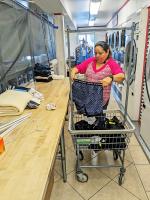CHICAGO — Gathered at the roundtable of self-service laundry industry expertise, a group of seasoned professionals engages in a virtual conversation that delves into the heart of current industry trends and future forecasts.
In this exclusive assembly of minds, American Coin-Op brings you a front-row seat to insights, analyses and predictions that may shape the trajectory of your business realms; responses were edited for length and for magazine style.
From cutting-edge technologies to capitalizing on shifts in consumer behavior, thought leaders from some of our industry’s equipment manufacturers and distributors offer a kaleidoscope of ideas and concepts, providing you with a compass to navigate the uncharted waters of tomorrow’s marketplace.
Q: Wash/dry/fold service has seen sizable growth in recent years. What has caused this growth? What are the keys to begin offering this service for the first time? How can existing WDF services continue to grow their customer base?
Joel Jorgensen, vice president of sales, Girbau North America:: Many vended laundries are growing WDF and expanding into residential and commercial pickup and delivery. While this expansion has been steady, the pandemic spurred its growth. Before you start wash/dry/fold, see how other successful stores are doing it. Get your tracking software in place, establish best practices, train staff, and start with drop-off WDF services. Expand into pickup and delivery once your staff is handling it well. Then you can grow your customer base by offering pickup and delivery services and/or through effective marketing.
King Lee, senior regional sales manager, Dexter Laundry: WDF has certainly grown in recent years, and I think one of the reasons is that a certain demographic enjoys the convenience of that service. Gen X, Millennials and even Gen Z are not becoming homeowners at the same pace as their predecessors. They enjoy the freedom of not having to do mundane chores, and they are willing to pay for it. There is a reason that the residential house-cleaning industry is also booming with an average growth of 20% year after year.
Before one ventures into the WDF sector, that person needs to decide if the added labor costs and responsibilities will equate to a larger profit. I know of several multi-store owners who have built a successful business model by not choosing to offer WDF services at any of their locations even though they are all fully attended. Conversely, I know a lot of successful businesses where the core revenue comes from WDF and pickup and delivery. The bottom line is what the owner wants out of his/her store(s).
Matt Miller, president, Coin-O-Matic: The margins are attractive/large. Smart operators have written software that helps simplify the process and have gone to market with it, thus promoting its benefits. A few systems even allow you to easily partner with the gig economy to offer pickup and delivery with a click of the mouse. The growth of social media groups have shown that laundromat owners are an extremely supportive community and like to share smart business practices.
To grow your customer base, remember that quality service keeps customers coming back and helps spread the word in a big way. Make sure your staff is well-trained and consistent in their production. Wrap your product in branded packaging. Know who your target customers are and work with your advertising agency to grab their attention. And don’t forget about the high-volume commercial accounts.
Don Tomasian Jr., vice president, DT Equipment Co.: Wash/dry/fold has always been a lucrative part of the laundry business. The implementation of COVID-19 protocols caused a spike in this vertical of our industry. With a little bit of employee training, a weight scale and receipt tickets, an owner can very easily begin to offer this service to their customers. This speaks to the importance of a well-thought-out marketing plan, which promotes this segment of the business offering your customer a broader menu of services.
Al Adcock, vice president of sales and marketing, B&C Technologies: Wash/dry/fold services are popular due to the ever-increasing demands on people’s time, especially those without a washer and dryer in their place of residence. Instead of taking off a day of work to do laundry and waiting at the laundromat for a few hours, the laundry can be done and waiting for you when it is convenient. It’s simply a way to “automate” a chore and create a bit more time to spend with family or friends, or to pursue an activity that you enjoy that isn’t laundry.
A drop-off service makes sense, as laundry attendants typically have enough time to perform this service during their regular day, which increases the profits of the store. Initially, the already installed machines can be used for drop-off service and be processed during slower times. Customers can be given a discount for laundry done during slower times, which will drive more business. The idea is to set the price at a point where you can get customers—but not all of your customers—to use the service!
Joe Fleming, national sales manager, Yamamoto North America: Yamamoto sees this from a unique perspective. With a strong presence in the challenging drycleaning industry, we recognize that a trend costing business there could be causing growth in the laundry industry. As garments are manufactured out of newer, more manageable materials, certain clothes that used to be “dry-clean only” can now be washed regularly. Tie that in with trends that are conditioning people to pay for services that handle simple daily tasks (grocery pickup, food delivery, etc.) and you get a unique growth opportunity that oftentimes doesn’t require any additional infrastructure. Not only are owners experiencing this, individuals are starting their own businesses every day and processing other people’s clothes in your store.
Gary Gauthier, national sales manager, vended laundries, Pellerin Milnor Corp.: WDF is one of those services that, depending upon the area, will take off as soon as customers find out about it. I find that customers for this service have a wide variety of reasons for wanting to pay for this work. It’s either a time-saver or the person would rather pay someone else to do it. But, I find that online marketing seems to be a consistent driver behind each of these businesses. It’s big enough that outside, web-based companies are organizing these services in multiple markets.
Mike Hand, vice president, North America Commercial Sales, Alliance Laundry Systems: Our free time is limited, and the laundry task is time-consuming. So, customers with the means are willing to pay a premium for a service that eliminates this task and gives them back their free time.
As for the keys to begin offering this service, first, assess if you have the staff and infrastructure to add an additional service. Remember, self-service is your priority; if WDF takes away from that experience for customers, your bottom line will take a hit. Owners also must assess if they have the space to take on the added service. WDF requires a significant amount of storage space for incoming and outgoing orders.
Adding pickup and delivery service enhances the convenience element for customers and can expand the coverage area/client base. Again, owners need to review their business and identify if they are positioned to add another layer of complexity. It’s a classic risk/reward situation.
David Hoffman, sales manager, Gold Coin Laundry Equipment: Wash/dry/fold continues to grow at a rapid pace because as people’s lives continue to get busier, there is less time for them to spend at a laundromat doing their own laundry. Laundromats are now making it even easier for wash-and-fold as more and more stores have started offering pickup and delivery service; in many cases, it can be scheduled right on the phone. In recent years, many companies have started aggressively marketing and advertising these services, and I believe this is what has caused the sizable growth.
In Thursday’s series finale: Hiring/retention, and how the industry might evolve through this decade
People who appear in this series of articles:









People who appear in this series of articles:









Have a question or comment? E-mail our editor Bruce Beggs at [email protected].



















